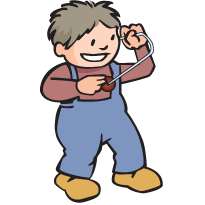Boston Children's Museum
308 Congress Street, Boston, MA 02210
617-426-6500
© Boston Children’s Museum 2025
Website Design by JackrabbitChildren’s bodies are undergoing constant change. By getting to know their own bodies better, these changes can be less mysterious. Children who are in tune with their own bodies can use all of their senses as tools as they explore and try to understand the world around them. This activity will help children to get better acquainted with their heart rate.
See Suggestions under “Make it Better” for information on where to fund funnels and tubing.
Cut the plastic tubing into pieces and 18″ long. You don’t have to be exact. You’ll need 1 piece of tubing for each child. Make a stethoscope to show your students – hold a balloon by the open part and cut it in half, a little bit past the area where the neck widens. Discard the half you usually blow into to inflate the balloon. Stretch the remaining half of the balloon across the wide part of the funnel – make sure it’s nice and tight (see figure 1 for an illustration).

Ask your students if a nurse or doctor has ever listened to their heart during a check-up or hospital visit. How did they do it? Did they use any special tools? What was the doctor doing? Do your students each know how many times their own heart beats in 1 minute?
Make your own stethoscope and measure how many times your heart beats in a minute!
After 5 minutes of activity, when some of the children have found their heartbeat, stop your students and bring them together to share their observations with each other. Where did they place the funnel on their chest? Does anyone have any other tips for using the stethoscope? This discussion should only last a few minutes.
Once everyone can hear their heartbeat, ask the entire class to be quiet, get their stethoscopes ready and on your signal, count their heartbeats. Time 1 minute, and then have everyone write down their heart rate. Ask your students if they think their heart rate is always the same. What will happen if they jump up and down for 2 minutes, then test their heart rates? What if they lay down and close their eyes for 2 minutes? What if they run around? Have them try all different sort of activities and measure their heart rates.